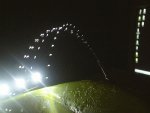Dears, first of all excuse my english.
I'm an italian guy with a problem to solve before the 24 of december.
I need to reach a fast ( more then 30 Hz i need the light to appear still ) strobo effect to freeze some droplets of water as a decoration for a little christmas tree.
I have tried with xenon flash of disposable camera, but the frequency is to fast to reach, and i don't like to work with 220 Volts AC and water at the same time.
So after years of attending this forum just reading how you guys solve the problems of everyone i hope you can help me to.
How to use a picaxe chip to drive some bright white led to achive the effect?
More specifically:
i know how to get a cicle of:
a pulse of 1 or 2 milliseconds
then a pause of 30 millisecond
and back to start...
But how to have a enough bright flash from a white led ( well... 20 leds) in so little time?
Be kind please if the answer is obvious or the question already treated
and thanks to everyone for the help.
I'm an italian guy with a problem to solve before the 24 of december.
I need to reach a fast ( more then 30 Hz i need the light to appear still ) strobo effect to freeze some droplets of water as a decoration for a little christmas tree.
I have tried with xenon flash of disposable camera, but the frequency is to fast to reach, and i don't like to work with 220 Volts AC and water at the same time.
So after years of attending this forum just reading how you guys solve the problems of everyone i hope you can help me to.
How to use a picaxe chip to drive some bright white led to achive the effect?
More specifically:
i know how to get a cicle of:
a pulse of 1 or 2 milliseconds
then a pause of 30 millisecond
and back to start...
But how to have a enough bright flash from a white led ( well... 20 leds) in so little time?
Be kind please if the answer is obvious or the question already treated
and thanks to everyone for the help.


